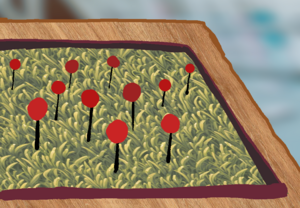Nihongo flower

The nihongo flower is an aggressively invasive and opportunistically parasitic flower in the domain that can grow on ground, on trees, and in many woody bushes. It is notable for being one of few successfully generalist mixotrophic plants in the area. The species was mistakenly introduced by known ecological miscreant Nihongo Jones, their namesake.
Description and life cycle
The "flower" of the nihongo flower is only a ball of its stigmata, which are tiny, point in all directions, and comprise a fine red fuzz. It is not a spadix, as most of the plant's mass is one singular flower starting at the roots. The entire gynoecium is contained in this ball, while the initially black stem beneath it houses several other parts of the plant until it blooms, such as the stamina.
Before blooming, the stem swells and turns white, filling with pollen and furled leaves. The outer layers of the stem, having differentiated into leaves, eventually burst out into a dense leaf cover around the plant, extending several times the stem's length as the leaves unfurl. This also releases pollen stored among the leaves, in a funnel-like mechanism that launches them into (and past) the stigmata. As in all NAME THIS CLADE, the leaves are synonymous with petals.
The nihongo flower only conditionally produces chloroplasts; photosynthesis appears to be largely vestigial, and the otherwise white leaves only turn green when the plant grows without sufficient nutrition from other organisms. However, the nihongo flower has a sharply decreased survival rate in environments where it must function as an autotroph, indicating that photosynthesis has become a last-ditch effort in case the plant's typical life cycle is not possible.
In most cases, the nihongo flower is a fungal parasite; that is, a parasite preying upon fungi. Most species preyed upon by the nihongo flower are pioneer species attacking the woody stems of trees and bushes. Initially there appears to be a symbiotic relationship at play, where nihongo flowers deny the host plant light during pioneer attacks on leafy branches, making it easier for the fungi to spread and colonize.
Once the fungal infection spreads further in the host plant, the nihongo flowers begin feeding more aggressively to facilitate new reproductive cycles, of which at least 10 are possible in one plant's lifetime, most after the tree has become weakened by the fungal infection or died completely. The nihongo flower's leaves in these later cycles are stunted, as they no longer need to deny light to the tree, and only serve to funnel pollen outward. It is also theorized that while the pioneer cycle(s) are primarily clonal, these later cycles' pollen dispersal facilitates genetic exchange between individuals to a greater extent.
As nihongo flowers tend to hang semi-horizontally out from smaller branches, hosts often look like a white-leaved tree has been spliced onto them. While most variants of the nihongo flower shed their leaves between reproductive cycles, some variants gain a "tiered" appearance over time, as old generations of leaves remain attached while withering, while smaller, newer ones stack on top of them.
The leaf-petals are quite thick and feature quasi-hexagonal vein patterning, tapering somewhat towards the outer edge. The nihongo flower's petals' shape can be described as resembling young plants of various paulownia species. White leaves tend to wither into lighter, gray tones, while leaves with more chloroplast tend towards more yellow or brown colours while decaying.